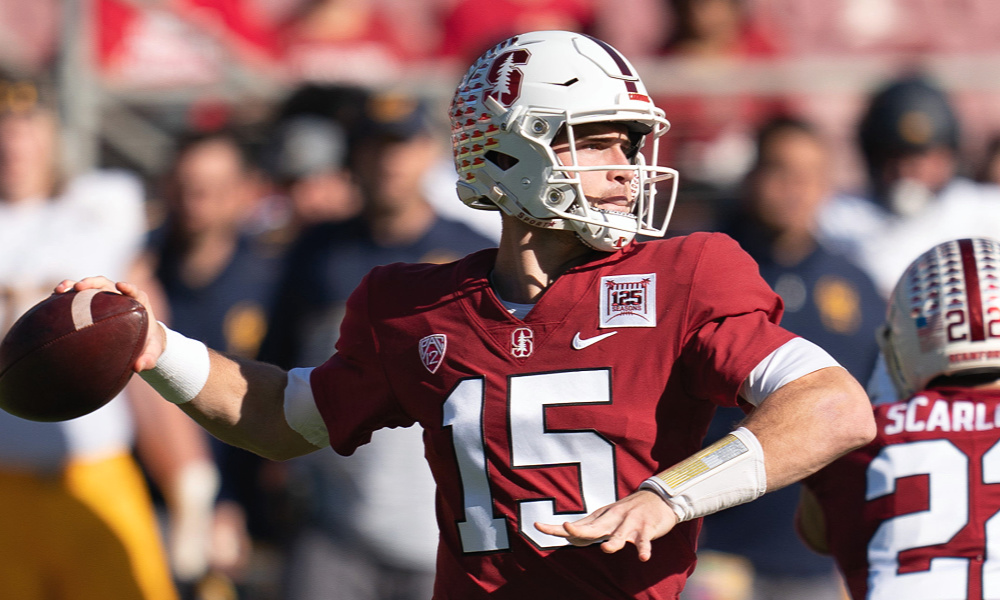
PAC-12 fans have long known Stanford football for its brute-bully mammoth linemen who push and grind and bulldoze freeway passages for running backs who rise to Heisman candidacies.
It was a scheme built by Jim Harbaugh in 2007 and in its first season, it produced a quadrupling of wins as well as the biggest point spread upset of all time—a 24-23 win over second-ranked USC, who entered the game as a 41-point favorite.
In Harbaugh’s four years, Stanford went from 1-11 to 12-1 with eight of those 2010 wins coming with margins of at least 25 points. Harbaugh’s tenure ended after the 2010 season and a 40-12 farewell blasting of Virginia Tech in the Orange Bowl.
Stanford was near the top of the football world and administrators wanted to keep it going. There was no better way to do that than to promote offensive coordinator David Shaw to head coach. After all, Shaw was a four-year disciple of the Harbaugh gospel and if anyone was devoted to its continuation, it was him.
Shaw adhered to the mission and he posted double-digit wins in six of his first seven seasons. In fact, that sixth season was his best, as the Cardinal went 12-2 and finished as the unanimous third-best team in the nation.
Since then, there has been a steady erosion of wins with no season having more wins than any season before. It’s been four years since Shaw won a conference title and total wins in 2019 are one-third of what they were in 2012.
So, what happened?
For quite some time, I attributed the Cardinal decline to the ebb and flow of talent and the randomness of events. But, it felt like there was more to it—like there was something funny on The Farm and it had more to do with choices and design than anything random.
Then, on December 28, 2017, Stanford lost to TCU 39-37 in the Alamo Bowl. It happened in an unexpected way and I decided to study things further. (You can read some of my findings here if you like.) If I would have had to study every play, I would have, but as it turned out, the evidence was as vivid and noticeable as … well … I suppose … a Cardinal in a Tree.
The greatest incongruity occurred as the game was winding down. Stanford trailed by just two points and had three minutes—more than enough time for a winning drive. Bryce Love was a Heisman finalist and had already sprinted for a 69-yard touchdown in the first half and it was the running attack that had given the Cardinal a 28-16 first half lead.
I was convinced that coach David Shaw and offensive coordinator Tavita Pritchard would adhere to the Harbaugh creed and power-rush the ball for a winning score.
But, that isn’t what happened. In those final three minutes, Stanford did not hand the ball off even one time! Instead, it turned to quarterback K.J. Costello, a sophomore with a modest 58% completion rate.
Costello’s first play was a delay of game. After that, two incompletions. And finally, he threw an interception to end Stanford’s chances.
Not only did Stanford abandon the running game when it mattered most, but in the final nine minutes, Bryce Love didn’t touch the ball even one time!
In the two years that preceded the 2017 Alamo bowl season, Stanford was 22-5 using the Harbaugh scheme of mammoth grinders and rushing the ball at least 60% of the time. Since then, Stanford is 22-16 and has never had a season with 60% rushing. In fact, in this 2019 season, Stanford rushes a mere 44% of the time, which has given Shaw his first losing season and a rush-effectiveness ranking of 115th in the nation.
But, this isn’t all on Shaw. There is another reason and it is key.
Remember earlier when we talked about that epic Stanford win over second-ranked USC and the biggest point spread upset of all time?
Guess who the starting quarterback was for Stanford. I’ll give you this hint: It wasn’t the usual starter T.C. Ostrander because he had suffered a seizure earlier in the week.
No, the starting quarterback for that epic win—a quarterback who was starting his first college game ever!—was none other than Tavita Pritchard, Stanford’s current offensive coordinator.
And Pritchard is not just a lifelong quarterback; he’s also the cousin of the Throwin’ Samoan, Jack Thompson. Quarterback-centrism runs in the family.
So now, is it beginning to make sense why Stanford went with a quarterback in that fateful bowl game?
And do you know which game was Pritchard’s first-ever as an offensive coordinator?
Yup, the 2017 Alamo Bowl.
And now that he has been the offensive coordinator in 2018 and 2019, is it easier to understand why Stanford has continued to steadily decrease from a 66% rush-to-pass ratio to just 44% this season?
It’s important to not blame Pritchard completely for the Stanford rush erosion because that began five years before Pritchard became the offensive coordinator. Every single year since 2012, the rush-to-pass ratio has been less than the year before. That belies intent. As much as eight years ago, Shaw began to transition from the Harbaugh model.
The problem is, his wins have been eroding slowly as well. Will he continue in this pursuit or is his first losing season enough for him to rededicate his life to the Harbaugh gospel?
His job isn’t on the line, at least not now. His former assistants, Derek Mason at Vanderbilt and Mike Bloomgren at Rice, are not in the crosshairs despite never posting winning seasons. Mason is only 3-8 at Vandy this year but he received a contract extension because elite academic institutions such as Stanford, Vanderbilt, and Rice are not “destinations” for coaches. Failure is more tolerable because replacements are rare.
So no, Shaw won’t be fired. He will be back. What I wonder is how long he will stick with Pritchard and if he will ever seek to regain the power of the Harbaugh model.
For those of you who long endured Stanford’s bully-boy football, be encouraged. The Stanford of Shaw is not the Stanford of Harbaugh. Those days are gone and are not likely to return soon.



Great point about Tavita Pritchard being their offensive coordinator.